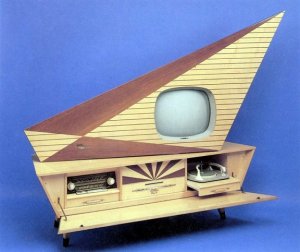fuzzybuddy
SF VIP
- Location
- The Sticks, Northeast PA.
Yes! Doesn't anyone remember how we used to wrap tin foil in a coil and wave it around the room until someone yelled, "Stand still! We almost have a picture!" Ha Ha Ha!Where's the aluminum foil????
Or stuck the antenna onto the wall with Scotch tapeYes! Doesn't anyone remember how we used to wrap tin foil in a coil and wave it around the room until someone yelled, "Stand still! We almost have a picture!" Ha Ha Ha!
Your Dad knew what he was doing. I was an electronics technician in the Navy during that time period and had a number of part time jobs as a TV repairman.My dad put two antennas on poles out in the yard. One was for Johnstown's station and the other for picking up Pittsburgh's stations. He had a switch inside we could flip back and forth. When the wind blew hard during the night he'd send us out the next day to turn them by hand until the picture was back to normal.
When you stand near the TV, your body actually becomes a reflective component of the antenna.Not much has changed for me.
I don't understand why standing next to the television improves the picture but only until you go back to your chair.
My dad was a coal miner for 45 years, but he was pretty handy with tools and had a knack for figuring out how things work. My oldest son has the same talent.Your Dad knew what he was doing. I was an electronics technician in the Navy during that time period and had a number of part time jobs as a TV repairman.
That same technology would work now if you don't want cable.My dad put two antennas on poles out in the yard. One was for Johnstown's station and the other for picking up Pittsburgh's stations. He had a switch inside we could flip back and forth. When the wind blew hard during the night he'd send us out the next day to turn them by hand until the picture was back to normal.
View attachment 95781
Hah. You youngsters with your phones, and social media. We knew how to work one of these. VHF, UHF, vertical hold-yeah, we did it all.

It's what children were forI don't understand why standing next to the television improves the picture but only until you go back to your chair.
Those big antennas had a very narrow beam and a very high gain. In those days the signal modulation mode was significantly different than it is today and fairly simple receiver systems were able to demodulate (process) the signal and pull out the original program. These days, the modulation mode is significantly different and requires more sophisticated receiver/demodulation equipment to extract the original programs. These new modulation modes have a higher signal demodulation processing gain and hence the requirement for super high gain antennas has been reduced.In the 1980's people could purchase huge satellite dishes
10 feet or so in diameter.
I was told, don't actually know, that they could bring in any
satellite program, or any information broadcast by a satellite.
Anyone have factual information on these giant dishes, I noted a lot of residents in rural retirement areas (high dollar folk) has these giant dishes.
In Houston in order to get a satellite signal your dish must face south. Wouldn't you think by now Directtv would come up with a more universal signal that could be picked up regardless of where the dish faces?
They could only bring in the satellite they were aimed at. They were huge because the signal was weak compared to now. The newer satellites have a stronger signal and that's why you can use a smaller dish. You also need a receiver to decode the signal and send it to the T.V. set. Aiming the dish is not an easy task. It has to be spot on. And the satellite people keep changing the code and cards in the receiver to prevent piracy. You rarely see the large dishes anymore because even the satellite itself has a limited life. A new satellite gets introduced and you have to aim at the new position.In the 1980's people could purchase huge satellite dishes
10 feet or so in diameter.
I was told, don't actually know, that they could bring in any
satellite program, or any information broadcast by a satellite.
Anyone have factual information on these giant dishes, I noted a lot of residents in rural retirement areas (high dollar folk) has these giant dishes.
